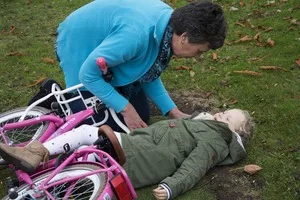
A few years back one of my daughters got her finger seriously mangled in a slammed door. The nail was loose and her finger was bleeding profusely. So, my wife rushed her to the immediate care center near our house. After waiting for a half-hour, they were ushered in to see a doctor who wrapped our daughter’s finger in a gauze bandage and told my wife to call an orthopedic doctor. That was it.
The next day, fortunately, they were able to squeeze into an orthopedic doctor’s schedule, who stitched our daughter’s nail back on, took an x-ray (the finger was fractured), and wrapped her finger up in gauze and vet tape. Not only was the visit to the urgent care clinic a waste of time and money, but it delayed any actual treatment for our very anxious daughter.
Now, I’m not suggesting that this is what always happens at urgent care clinics, but it does raise the question: what should you do if your child gets injured in an accident this summer, the busiest trauma season of the year?
According to a recent article in the Chicago Tribune, if the injury looks serious–if it involves a broken bone, a deep cut, severe bleeding, an allergic reaction, a serious fall or difficulty breathing–doctors recommend the emergency room as your first choice.
Urgent care centers, while they tend to be cheaper and less crowded, usually do not have the ability to treat these types of injuries. If you go to one of these facilities with a serious injury, you will probably be told to go to the emergency room or to see a specialist anyway. Immediate care clinics are more appropriate for minor illnesses or injuries such as a nasty insect bite or sunburn.
Emergency rooms have the staff and equipment to deal with serious injuries. They can take x-rays, order labs, set broken bones, stitch up wounds, and perform surgery if necessary. The downside is that ER visits generally cost more, and you will most likely have a long wait to be seen. To lessen that wait, find out if any nearby hospitals have a pediatric emergency center, like Edward Hospital in Naperville, or call several emergency rooms in the area. The wait at one may be much longer than the wait at another. And always tell your pediatrician of any emergency room visits. Follow up care is important and an appointment with a specialist may be in order after your trip to the ER.
Case in point: some athletic injuries, such as ligament tears, are not always diagnosed correctly in an emergency room setting. After our daughter injured her knee in a soccer game, the emergency room staff took an x-ray and told her that she had a bruised knee bone. At the advice of our pediatrician, we took her to an orthopedic doctor who ordered an MRI, which showed a complete ACL tear. If your child has a serious athletic injury, head to the ER, but follow up with a specialist soon after.
Preventing injuries is obviously the best option, but sometimes, no matter how cautious you are with your children, accidents happen. Don’t beat yourself up about it. Take a deep breath, assess the situation, and head to the ER if you think that your child may be seriously injured.

"*" indicates required fields